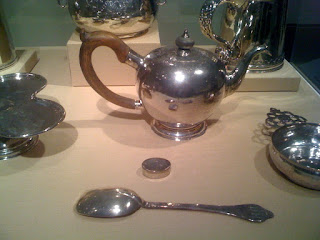Lately, whether due to inclement weather or perpetual lack of funds, the CTA (Chicago Transit Authority) has been crowded. This isn’t news to anyone who regularly commutes during rush hour(s). But the other day 5 trains passed me by before I squeezed myself between two large coats and was carried onto the train by sheer force of the tide.
Both on the platform (which was so crowded, people began to sort themselves into layers) and on the train I began to think about crowds. In the 19th century, Charles Baudelaire mused that his vision of the painter of modern life would be a “Man of Crowds:
“[The artist] loves mixing with the crowds loves being incognito, and carries his originality to the point of modesty…
Sitting in a cafe, and looking through the shop window, a convalescent is enjoying the sight of the passing crowd, and identifying himself in thought with all the thoughts that are moving around him.
The crowd is his domain, just as the air is the bird's, and water that of the fish. His passion and his profession is to merge with the crowd. For the perfect idler, for the passionate observer it becomes an immense source of enjoyment to establish his dwelling in the throng, in the ebb and flow, the bustle, the fleeting and the infinite.”
As I watched the trains arrive, one after the other they were packed like sausages, too full to accept additional passengers. When the doors opened it reminded me of the dangers of unbuckling one’s belt after a full meal—there is a chance one might not be able to rebuckle! To be perfectly honest, the rush and hurry towards the open doors seemed a little like this:
 |
| Luca Giordano, The Abduction of the Sabine Women, 1675/80 (Gallery 211, AIC) |
It may not have been as violent as Giordano’s retelling of the ancient Roman story. Certainly, half of the figures are in struggle with another half but certain details of hands on heads, elbows jutting into knees and shoulders to the ground evoke that body-on-body frantic pushing and shoving that ignites in peoples’ minds once they hear the clicking and scraping of the subway car doors opening.
For 19th century Parisians, the city was a place of new anxieties. New forms of transportation invited more and more people into the city. New roads allowed more and more people to traverse the streets. There was more and more opportunity for people to mix, purposefully and accidentally. The constant threat of coming into physical contact with strangers was a particularly wrought worry among upperclass women, the fear of which might have dissolved into the state of chaos in Giordano’s paintings. Though there was worry that the crowd would never dissipate, there was an excitement as well. There was an energy to be drawn from the hustle, bustle, constant bumping and “’scuse me’s.”
 |
| Camille Pissarro, The Place du Havre, Paris, 1893 (Gallery 201, AIC) |
With quivering brushwork, Pissarro squiggles in a crowd. If we didn’t read them as people, we might read them as pleasant greenery, nicely trimmed topiaries at the base of the newly built Haussman-style architecture. Even the streets have a powerful directional flow. One that reminds me of the dance floor at a honky tonk where the traffic of two-steppers goes in a constant circle—break it and be crushed. If we get too caught up in the whirl of traffic below, the shouts of carriage drivers, the murmur of calls, laughter and pointing by the sidewalk traffic we need only to step away from our balcony. Pissarro has given us respite from the crowd by placing us above it where we can survey its entirety or immerse ourselves in conversations and interactions using the zoom lens of our imagination. We become Baudelaire’s observer of modern life and its crowds with that ability to absorb oneself in it’s intricacies while still remaining distant.
Contemporary artist, featured on PBS’s Art:21 series, Kimsooja might be Baudelaire’s Man of Crowds for our own age.
This is a short clip that featured excerpts from her video pieces. The full episode is here. Kimsooja’s works are discussed in the first 20 minutes.
She stands, as she says, “like a needle” stabbed into the earth so that its motions, traffic and constant flow of people and words flow around her. Something about it is beautifully stubborn. Her stillness, however, is quickly absorbed by the crowd. She is among the crowd but not a part of its movement and flow. We, too, become observers of the mass of moving people and she becomes a surrogate for us to participate much like the viewpoint from Pissarro’s balcony.
I wouldn’t recommend taking a sudden halt the next time you are in a crowd as this may lead not only to a domino-effect but some scolding words as well. If you stop in a crowd, take note of that slight mental shift from when one is a part of the traffic and flow to when one is distant from it while still being a part of it. Perhaps, as Baudelaire suggests, it will feel a bit “incognito!”



















